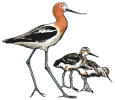Watershed Watchers
The Watershed Watchers program is a partnership of the Santa Clara Valley Urban Runoff Pollution Prevention Program (SCVURPPP), the U.S. Fish and Wildlife Service, and the San Francisco Bay Wildlife Society.
The purpose of the Watershed Watchers program and SCVURPPP is to prevent urban runoff pollution (pollution coming from a myriad of sources, such as oils from vehicles, detergents from washing things outside, litter, and pet waste) and increase the surrounding communities’ knowledge of such pollution, and how to reduce its harmful effects through personal behavior.
This purpose is accomplished through many avenues, with the most popular being the interpretive and stewardship programs offered at the Environmental Education Center.
Programs such as bird watching hikes, night sky parties, owl programs, history programs, and others, give visitors an introduction to local wildlife and how they are directly affected by our actions.
Outreach is also an important component to spreading the message of pollution prevention, with visits to local school science nights, community festivals, and other environmental organizations. Community service projects allow participants to really make a difference, removing invasive plants, learning about native gardening and eliminating the use of pesticides and other chemicals. Partnerships with other like-minded organizations, such as the Santa Clara Valley Open Space Authority, Keep Coyote Creek Beautiful and the San Francisco Bay Bird Observatory, help further our reach to different areas of the community.
Highlights include large scale events such as World Migratory Bird Day, Shark Day, and Wheels and Wildlife. These events often attract over one hundred visitors, who learn about local and migratory birds, our connection to San Francisco Bay, and native wildlife. Activities are geared toward teaching people about the impact to local habitats and wildlife. California Coastal Cleanup Day and National River Cleanup Day get local communities involved in stewardship and are opportunities to help spread the message of preventing urban runoff pollution.
The Watershed Watchers program has been a vital part of the Environmental Education Center’s success, putting on great programs for the public, and giving the community opportunities to learn about urban runoff pollution and then make better choices in their everyday lives to help local wildlife and in turn, help improve their own quality of life as well.
Habitat Restoration Service Learning Field Trips
Field trips include a habitat hike on the boardwalk and levee trails to see the five habitats at the Refuge, followed by restoration work. Restoration of the upland habitat involves improvements in the Butterfly Garden and surrounding areas by removing invasive plants and planting native plants. A trash pickup using the Litterati app to document the types of trash found can also be included in the field trip. Field trips are limited to a maximum of 35 students with a minimum of 10. Field trips are 10:00 a.m.-1:00 p.m. and includes time for lunch. Programs will be offered September-May on Tuesdays and Thursdays at the Environmental Education Center in Alviso. Due to funding restrictions, program numbers are limited and first priority will be given to schools located within Santa Clara County. Please contact the Watershed Watchers Program Coordinator at watchershedwatchers@sfbayws.org or call (408) 515-1889 to set up your field trip.SCVWD Litterati™ Pollution Prevention Project
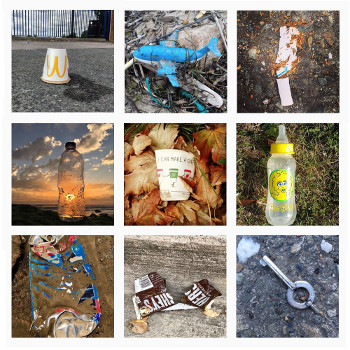 The Don Edwards San Francisco Bay NWR Clean up was the first project in the Refuge Complex to embed technology into a litter cleanup program and was funded by a Santa Clara Valley Water District (SCVWD) Project B3, Pollution Prevention grant in 2016. The Watershed Watchers Coordinator for San Francisco Bay Wildlife Society oversaw this project and partnered with San Jose Conservation Corps, Litterati, U.S. Fish and Wildlife Service, and Santa Clara Valley Water District. Funding was also provided in part by Clean Harbors Environmental Services, San Francisco Bay Wildlife Society, and Whole Foods Market - through their Nickels for Non-Profits program. We appreciate their generous support.
The Don Edwards San Francisco Bay NWR Clean up was the first project in the Refuge Complex to embed technology into a litter cleanup program and was funded by a Santa Clara Valley Water District (SCVWD) Project B3, Pollution Prevention grant in 2016. The Watershed Watchers Coordinator for San Francisco Bay Wildlife Society oversaw this project and partnered with San Jose Conservation Corps, Litterati, U.S. Fish and Wildlife Service, and Santa Clara Valley Water District. Funding was also provided in part by Clean Harbors Environmental Services, San Francisco Bay Wildlife Society, and Whole Foods Market - through their Nickels for Non-Profits program. We appreciate their generous support.
The purpose of the SCVWD Litterati™ Pollution Prevention Project is to prevent trash found in the Refuge from entering the local watershed system, and educate the public on pollution prevention utilizing a new technique in the way litter cleanups are conducted. The project involved using an app called Litterati to collect information on the trash found at Don Edwards San Francisco Bay National Wildlife Refuge in Alviso, CA. The project team took photos using the Litterati app, wrote hashtags describing the type of trash photographed, and uploaded the photos to the Litterati database. This data has been collected since September 2016 by the Watershed Watchers team. It will be used by the Refuge and the Litterati team to educate companies and the public, with the goal of reducing the amount of trash entering our ecosystems.
This project has collected over 12,600 photos and removed over 2.7 tons of trash as of June 8th, 2017. Over 4,000 people have participated in this project including school, restoration, and corporate volunteer groups, as well as educating the public at outreach events. Collecting trash using the Litterati app will soon be introduced as a citizen science project within the Watershed Watchers program. There will also be a display coming soon to the Don Edwards San Francisco Bay National Wildlife Refuge, Environmental Education Center identifying the effects of trash on our local habitats.
This is an ongoing project being managed by the Watershed Watchers program, so check back to see our progress! If you are interested in getting involved with this project contact the Watershed Watchers Program Coordinator at watchershedwatchers@sfbayws.org or call (408) 515-1889.
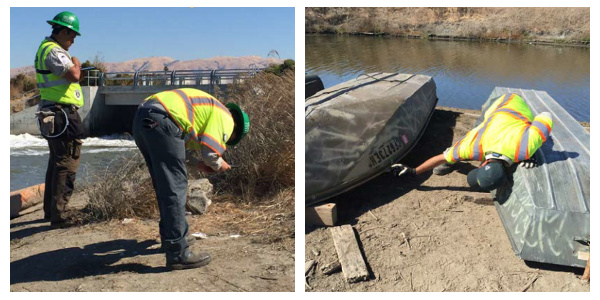
San Jose Conservation Corps cleaning up various ponds and levees in the south San Francisco Bay as part of the Litterati project. Credit Olivia Andrus.
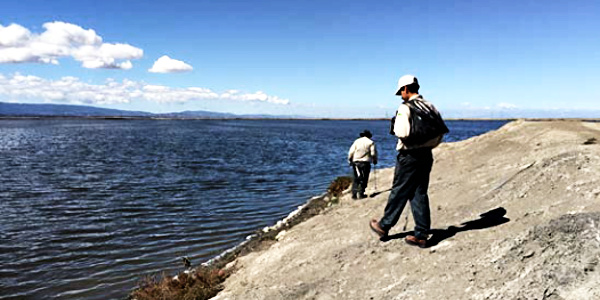
San Jose Conservation Corps cleaning up various ponds and levees in the south San Francisco Bay as part of the Litterati project. Credit Olivia Andrus.
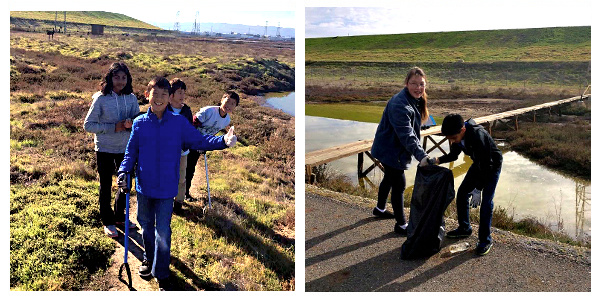
6th Grade class students at Merryhill Middle School collecting trash for the Litterati project. Credit Olivia Andrus.
Watching Our Watersheds
A powerful, interactive and free educational tool is now available for educators everywhere, and for visitors to the Don Edwards San Francisco Bay National Wildlife Refuge. If you’re curious about the creeks, baylands, and urban drainage networks, or would like to teach your students about the local watershed, this computer program using satellite technology may be just the tool.
Watching Our Watersheds (WOW) is a project to map the creeks, urban drainage networks, watersheds, baylands, and points of interest in Santa Clara Valley. Anyone can now download these maps and view them interactively through Google Earth.
These maps have many layers including past landscapes of the San Francisco Bay. With WOW you can compare the waterways and habitats of the late 1800s to the present-day landscape. Within the maps exist points of interest such as diaries of Forty Niners who stopped in San José on their way to and from the gold mines, lists of birds and plants from early botanists and ornithologists, and some of the earliest landscape photography taken in the state. Archives were searched for every photograph, map, and manuscript revealing aspects of the Santa Clara Valley’s former ecological landscape. Each map comes with a User’s Guide to navigating in Google Earth and answers to FAQs about the WOW project and the individual layers in the map. The maps cover western, central and southern Santa Clara County.
This interactive program allows educators to show pathways of urban runoff and teach about watershed health. Currently, the Living Wetlands program uses WOW in the classroom to locate the student’s school to show what watershed they are in, the closest water body to the school, and the type of historical habitat they are in. It is used to teach what urban runoff is and ways to reduce it. Intern Diane Luu observed that when WOW was presented in the classroom, &quo;the kid’s eyes lit up just being able to see an aerial view of their school. It really tied in everything the students had been learning about watersheds and helped create the connection of personal responsibility&quo;. Students and teachers can add their own points of interest and personalize their own watershed map.
Go to the Santa Clara Valley Water District Website and begin using this great resource!
You can also visit the new computer station at the Environmental Education Center in Alviso. With touch screen capabilities you can locate your home, find your local wastewater treatment plant, or follow the storm drain in front of your school. The kiosk also offers information on storm water pollution prevention and history of the bay. The kiosk even features endangered species and illustrate where certain endemic and native species can be found.
The watershed maps were prepared by Fugro Consultants, Inc. with the San Francisco Estuary Institute, the Oakland Museum of California, CLEAN South Bay, and many other collaborators and colleagues. Major funding was provided by the San Francisco Bay Wildlife Society, along with Santa Clara Valley Water District, Committee for Green Foothills, City of Palo Alto, Santa Clara County Creeks Coalition, and Santa Clara Valley Urban Runoff Pollution Prevention Program.
For western Alameda County watershed maps in the Google Earth format, check out the Oakland Museum of California’s web site.
